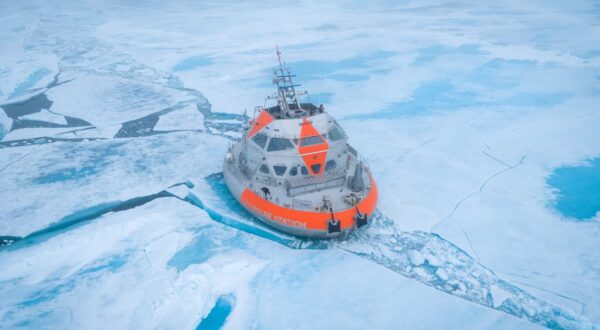[Blue Carbon] Is marine geoengineering a solution for fighting climate change?
The ocean is both a contributor to and a victim of climate change. Its capacity to store carbon makes it a valuable ally, but also an extremely sensitive environment. Before turning it into a technological tool, it is essential to understand and preserve it. Blue carbon embodies a promise: that of a renewed alliance between nature and science. But this promise will only be fulfilled if we act with caution, ethics and humility, always bearing in mind that the best climate solution remains one that avoids emissions in the first place.
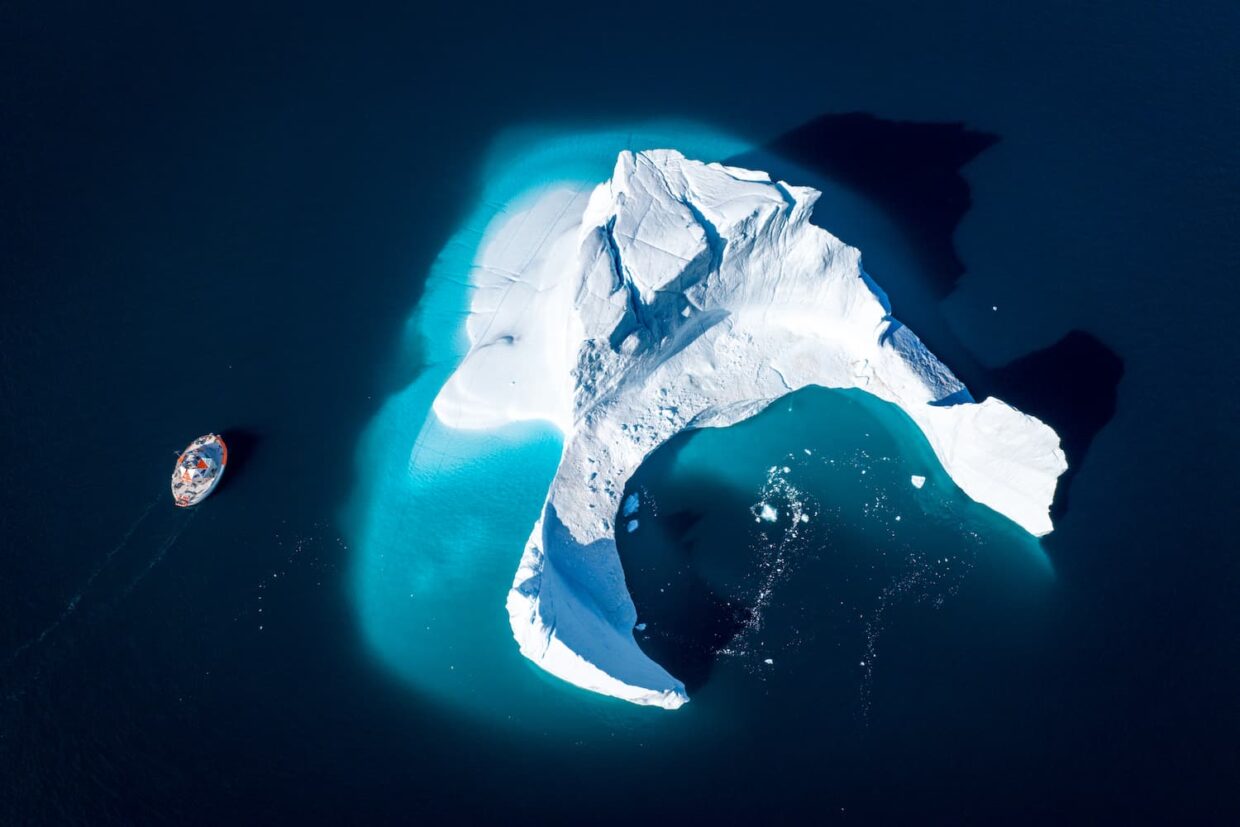
The ocean, an ally of the climate
The ocean, which covers more than 70% of the planet, plays a major role in regulating the climate. Every year, it absorbs around a quarter of the carbon dioxide (CO₂) emitted by human activities, thereby limiting global warming. However, it is important to understand that this carbon is part of a global cycle, in which carbon sequestration offsets natural emissions. By capturing ever-increasing amounts of carbon, the ocean is disrupting its chemical and biological balance.
In recent years, many stakeholders have sought to enhance the ocean’s natural capacity to sequester carbon, known as “blue carbon”, in order to meet climate targets. More recently, marine geoengineering techniques have entered the discussion.
What are they? Are these solutions effective? What impact do they have on the ocean?
What is blue carbon?
Mangroves, seagrass beds and coastal wetlands play a major role in regulating the carbon cycle. Through photosynthesis, these ecosystems absorb atmospheric CO₂ and store some of it in biomass and marine sediments, sometimes for long periods of time. Their biological richness and their ability to protect coastlines, filter pollutants and maintain essential chemical balances make them valuable climate regulators.
Blue carbon refers to carbon captured by these marine and coastal ecosystems.
However, so-called “blue carbon” ecosystems are among the most threatened environments. Their destruction disrupts these balances and releases accumulated carbon, transforming these regulators into sources of emissions. Protecting these ecosystems is essential to mitigate the effects of climate change and support the natural cycles that maintain the balance of life.
Can we talk about ‘carbon sinks’?
These ecosystems associated with blue carbon are often referred to as ‘carbon sinks’, as if they enabled massive carbon capture without net emissions.
In reality, carbon follows a natural cycle, in which it circulates continuously between the air, water, soil and living organisms. Before the industrial era, this cycle was broadly in balance: the carbon absorbed by photosynthetic organisms offset that released by respiration, decomposition and volcanoes.
In the ocean, as on land, carbon almost always ends up returning to the atmosphere. Rather than sinks, it would be more accurate to refer to them as regulators of the cycle of life, which cushion our excesses but cannot compensate for them in the long term or correct the imbalance we have created.
These ecosystems remain absolutely essential to global climate balance: they contribute to climate stability, support biodiversity and ensure the resilience of environments in the face of human disturbance.
Plankton, a major carbon store in the ocean
Long overlooked in the concept of blue carbon, plankton (phytoplankton and zooplankton) is a vital component of marine food webs and plays an essential role in regulating the global carbon cycle.
Through photosynthesis, phytoplankton captures as much carbon each year as all the forests on Earth. But this carbon does not remain stored: most of it is used to feed the marine food chain and is therefore quickly recycled through respiration and decomposition in the surface layers.
A small fraction of this organic matter is carried to the depths by the biological pump, where carbon can remain isolated for centuries. This process, although quantitatively limited, is essential to climate stability.
Often referred to as the ‘invisible majority of the ocean’, plankton plays a dynamic role in the cycle of life: it circulates carbon between the air, water and biosphere, ensuring the ocean’s planetary respiration.
But in climate discussions, many now see it as a providential carbon sink capable of sequestering significant amounts of CO₂ through photosynthesis and exporting it to the depths of the ocean.
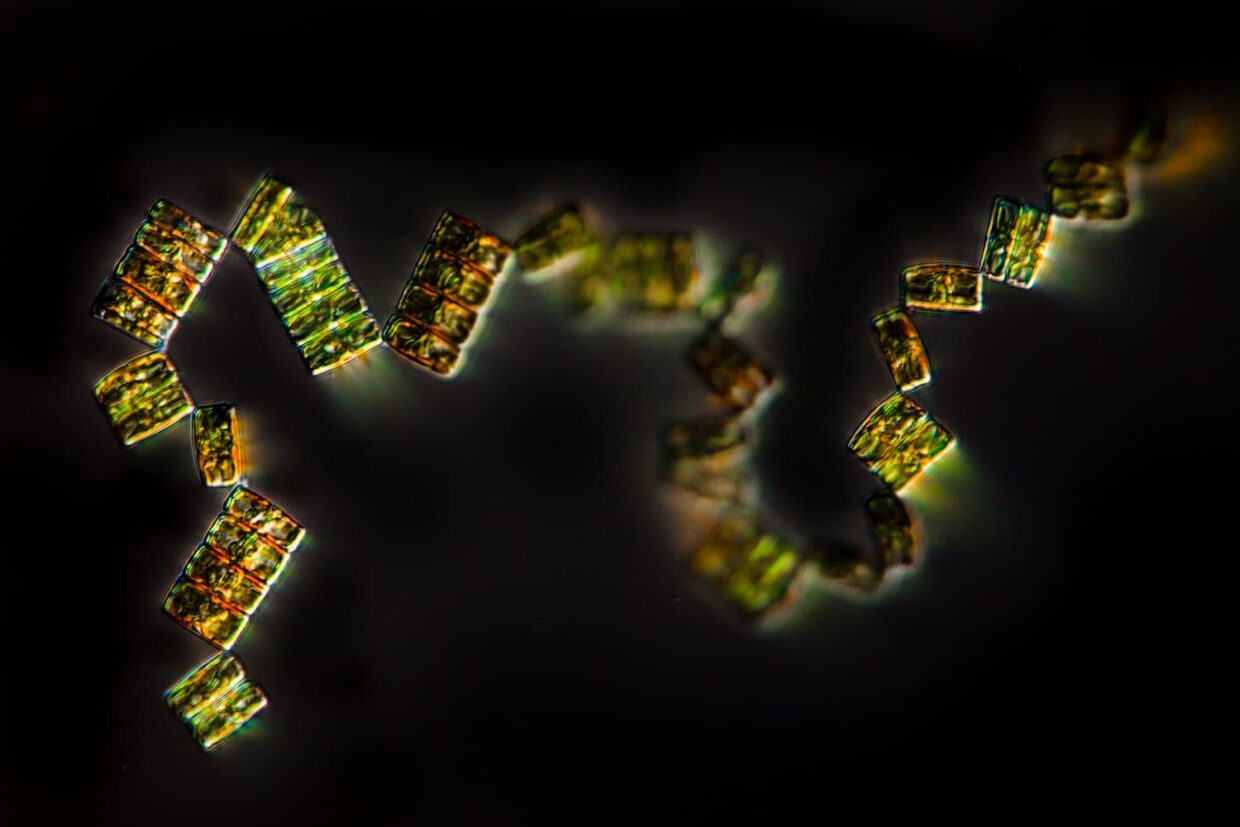
Marine geoengineering: altering marine ecosystems
To amplify this carbon trapping, researchers and industrial players are increasingly interested in marine geoengineering techniques: from ocean fertilisation to ocean alkalisation, a variety of techniques are now being studied to maximise the ocean’s carbon sequestration potential and mitigate the effects of anthropogenic emissions.
Different approaches to blue carbon geoengineering
• Ocean fertilisation
It involves adding nutrients (such as iron) to certain areas of the ocean to stimulate phytoplankton growth. The aim is to increase CO₂ absorption through photosynthesis.
• Alkalisation
This technique involves adding crushed minerals (such as limestone or olivine) to increase the pH of seawater, thereby increasing its capacity to absorb CO₂.
• Artificial upwelling
Mechanical pumps could bring nutrient-rich deep water to the surface, stimulating the biological production of phytoplankton.
• Direct injection of CO₂
Some projects envisage injecting captured CO₂ into the depths of the ocean or into underwater geological formations for long-term storage.
• Biological control of harmful algal blooms (HABs)
By introducing predators into targeted areas, this technique aims to reduce harmful algal blooms and thus limit ecological imbalances.
• Permanent carbon sequestration
In order to improve carbon solubility, surface water should be cooled, for example using microbubble techniques, to increase CO₂ solubility.

Potential impacts of geoengineering on marine life
Recent studies highlight potential risks to marine biodiversity:
- Disruption of nutrient cycles and availability: fertilisation techniques can cause nutrient imbalances, alter nutrient cycles and even create dead zones.
- Proliferation of harmful algae
- Ocean acidification: by dissolving more CO₂, carbonic acid is formed, lowering the pH of the water and weakening corals, molluscs and calcifying plankton.
- Changes in biodiversity: these result in alterations in productivity, species composition and ecosystem structure, with impacts on fishery resources.
- Unintended effects: these may include uncontrolled ecological and climatic feedback loops, loss of biodiversity, and potential ineffectiveness of marine carbon dioxide removal (mCDR) strategies.
Preventive approach to marine geoengineering
These techniques appear promising because they offer theoretical potential for massive carbon sequestration and, according to their designers, could complement efforts to reduce emissions.
However, given the known and unknown impacts, and the lack of a reliable method for measuring and guaranteeing the permanence of stored carbon, any large-scale approach is risky for biodiversity and the stability of marine ecosystems.
Finally, relying on these technologies perpetuates the illusion of a ‘miracle solution’ and distracts from the efforts needed to reduce emissions at source.
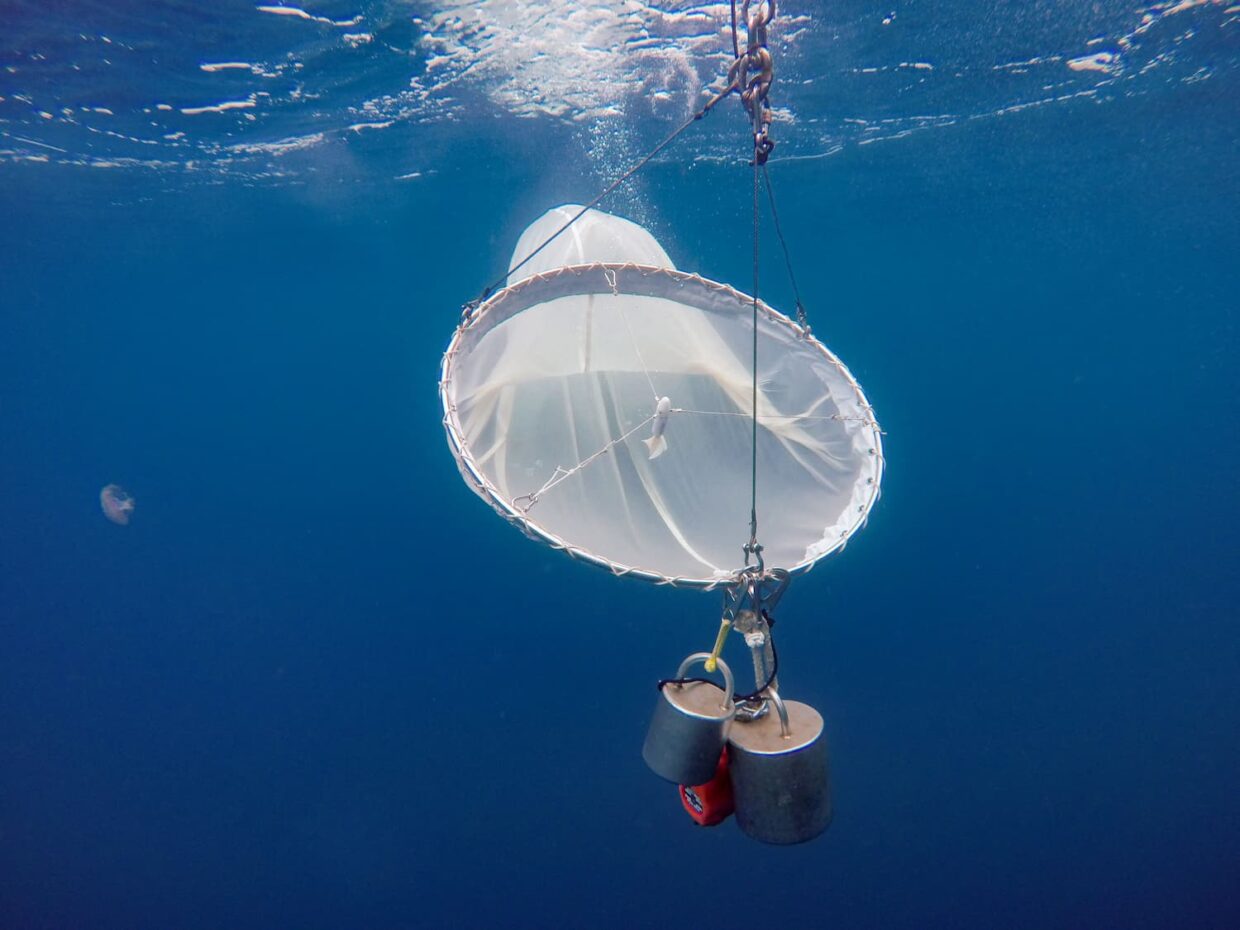
Legal frameworks still cautious
International bodies already regulate certain marine geoengineering practices:
- In 2010, the Convention on Biological Diversity (CBD) established a moratorium (a legal suspension of an act or activity) on most geoengineering activities likely to affect biodiversity, with the exception of small-scale scientific experiments under strict conditions.
- The London Protocol (1972; 1996) prohibits the dumping of materials or substances at sea for fertilisation purposes; only controlled scientific research is permitted.
- The new Treaty on Biodiversity Beyond National Jurisdictions (BBNJ, 2023) requires environmental impact assessments to be carried out for any activity likely to affect biodiversity beyond national jurisdictions.
These frameworks emphasise the need for a cautious, ethical and transparent approach before any experimentation takes place.
At the Tara Ocean Foundation, we advocate for the application of the precautionary principle and reflect on the ethical imperatives related to the management of marine ecosystems in the face of anthropogenic climate change.
We offer key recommendations to promote responsible and equitable decisions regarding marine geoengineering that preserve both the integrity of the ocean and the well-being of future generations.
Carbon sequestration on land
The recent history of carbon sequestration on Earth offers valuable lessons. Reforestation, soil storage and direct air capture (DAC) have often been presented as viable solutions. However, many of these projects have proved costly, ineffective and far removed from the complexity of the carbon cycle.
Like the ocean, terrestrial ecosystems already participate in a balanced cycle in which carbon circulates naturally between the biosphere and the atmosphere. Attempting to ‘sequester’ carbon to offset the surplus carbon linked to human emissions often amounts to forcing this cycle, with uncertain and sometimes counterproductive results.
Some forests planted to offset emissions have been destroyed by fires or deforestation, releasing the accumulated carbon. Other projects have shown a negative carbon balance once the energy required for their implementation has been taken into account.
These examples highlight an obvious fact: no carbon capture technology can replace an ambitious emissions reduction policy. Geoengineering, whether terrestrial or marine, should only be considered as a temporary supplement, not as an alternative to transforming our production and consumption patterns.
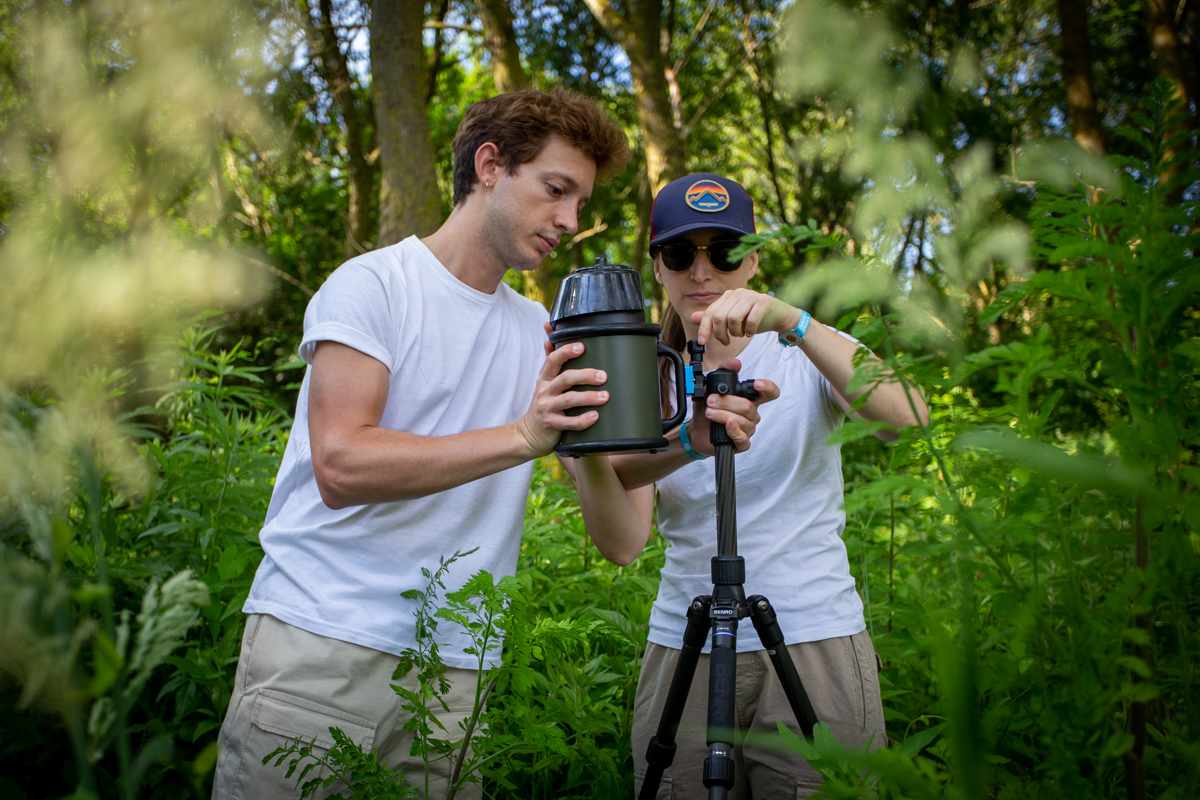
Towards responsible ocean management
Beyond the technical aspects, geoengineering raises fundamental ethical questions.
To what extent can we manipulate natural systems to correct the imbalances we have created? Who will decide which areas to experiment with, and who will bear the risks if it fails?
Furthermore, the benefits and consequences of these projects are likely to be unevenly distributed. Coastal communities, which are often the most dependent on the health of marine ecosystems, could be the first to be affected by any impacts.
Like the calls for a moratorium on deep-sea mining, many stakeholders, including the Tara Ocean Foundation, are therefore advocating for a global moratorium on large-scale interventions until their real effects are better understood.
Scientific uncertainties and ethical dilemmas require caution, humility and transparency.
Altering the vital processes of the ocean in order to maintain unsustainable lifestyles raises fundamental questions about our relationship with nature and living things.
Geoengineering and the Climate Change Conference
Since COP28 (Dubai, 2023), discussions around marine geoengineering have intensified, with some seeing it as a miracle solution to the climate crisis. But this perspective risks once again diverting attention away from the efforts needed to reduce emissions at source.
During the 2024 COPs of the CBD (Cali) and the UNFCCC (Baku), discussions highlighted:
- The need for equitable, science-based governance frameworks.
- The risk of premature implementation, driven by carbon markets.
- The importance of maintaining a focus on reducing emissions rather than offsetting them.
As we enter this still unexplored field of ecosystem modification, it is imperative that we proceed with caution. Planktonic ecosystems, although powerful carbon stores, are dynamic and sensitive environments, where complex ecological interactions intertwine that we have yet to understand.
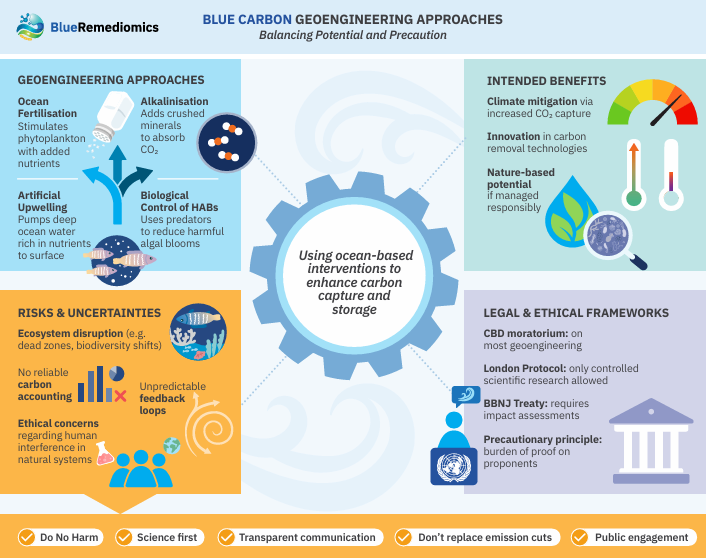
Key points to remember about marine geoengineering
- There is no scientific consensus that marine geoengineering is risk-free..
- There is no reliable carbon accounting method to assess the sustainability of storage.
- In the absence of certainty, the precautionary principle must apply to all geoengineering activities.
- Meeting the Paris Agreement targets requires a 40% reduction in emissions by 2030: the priority must remain reduction at source, before any offsetting.

